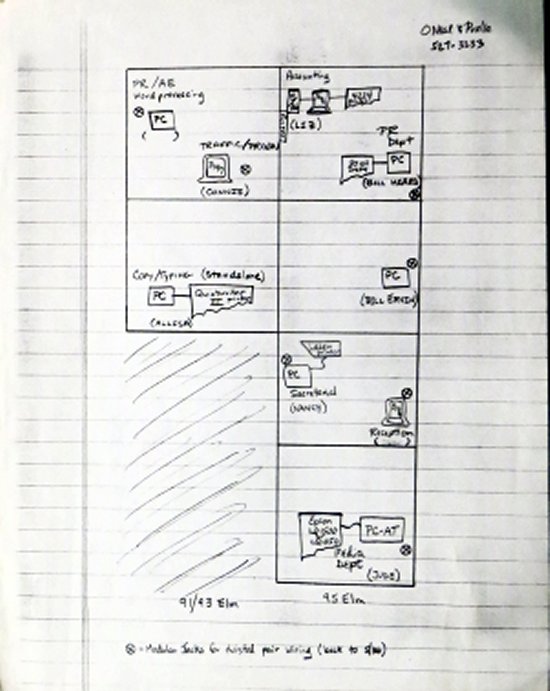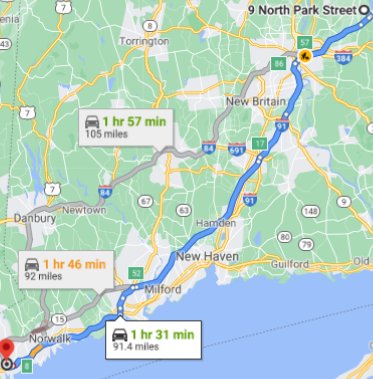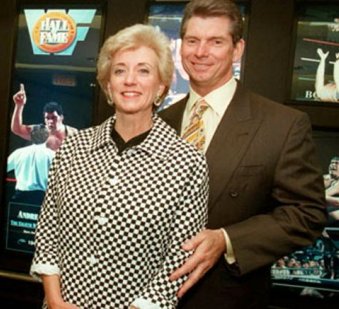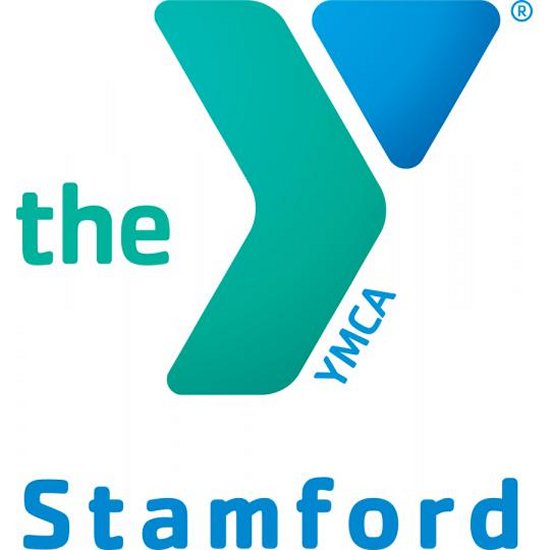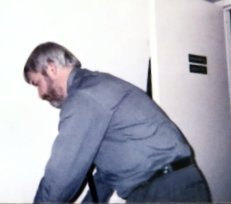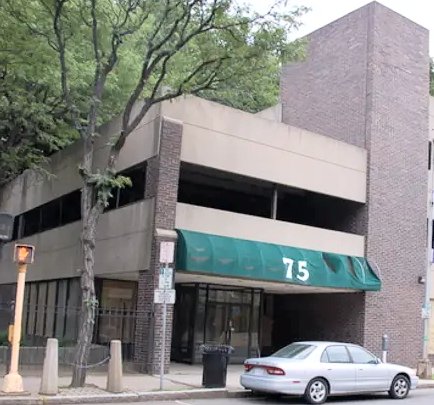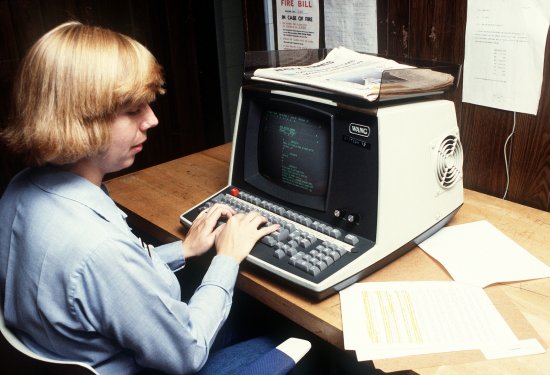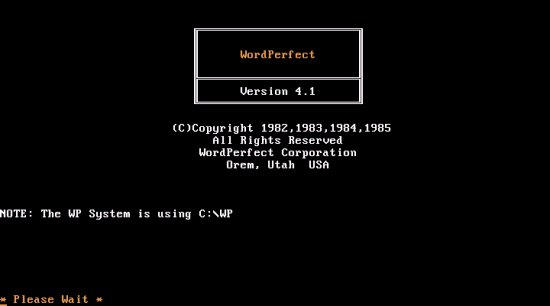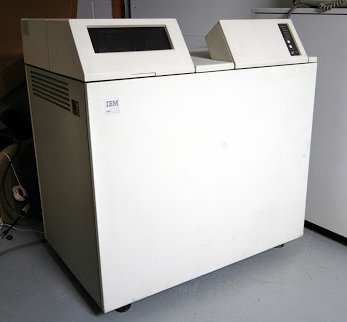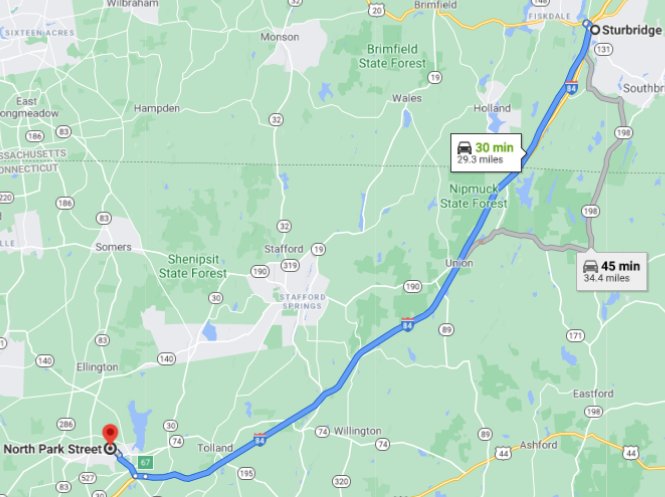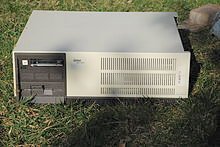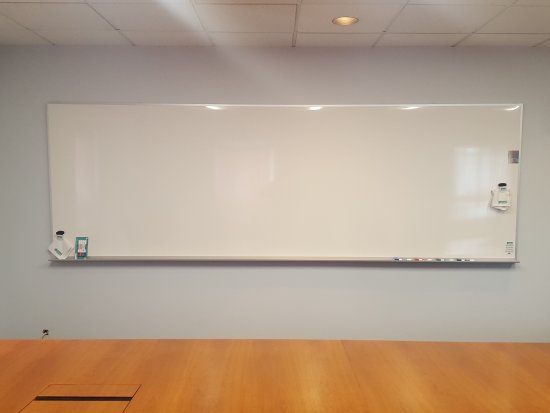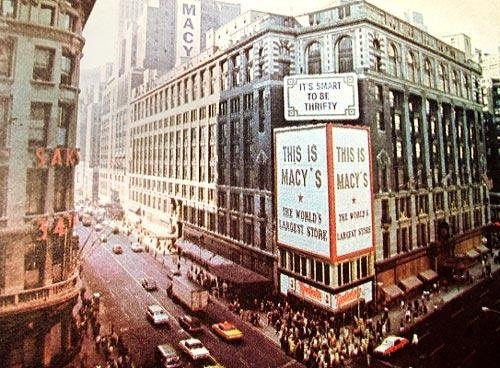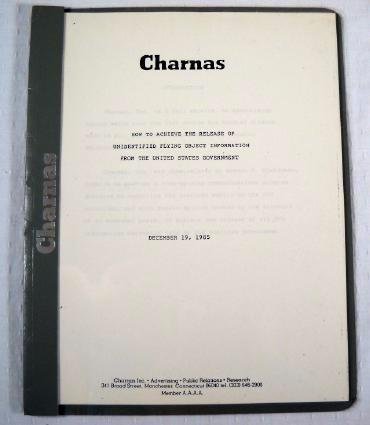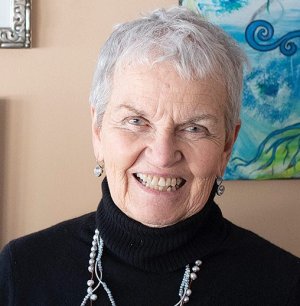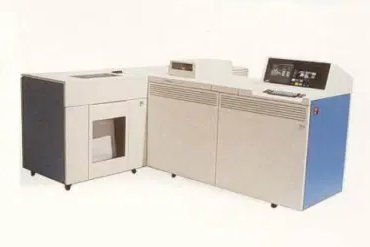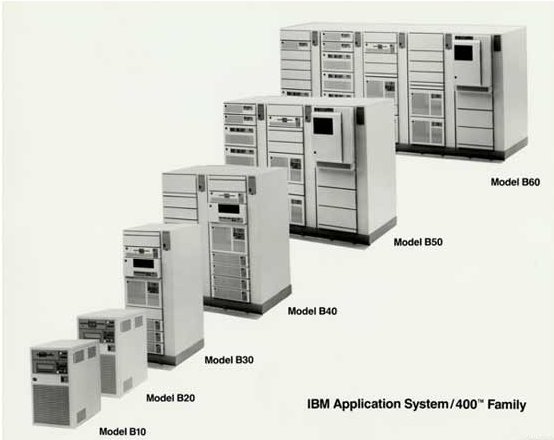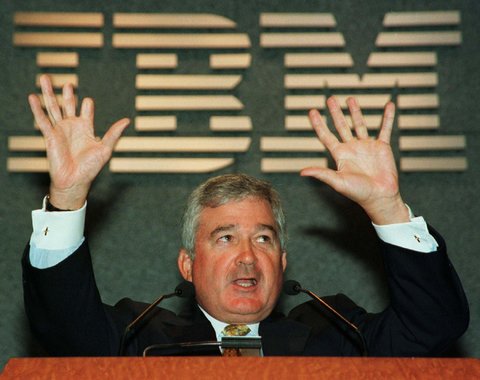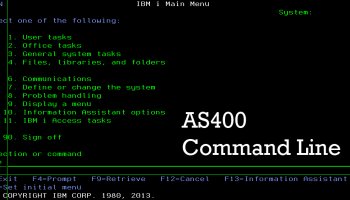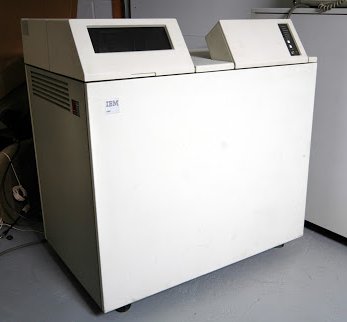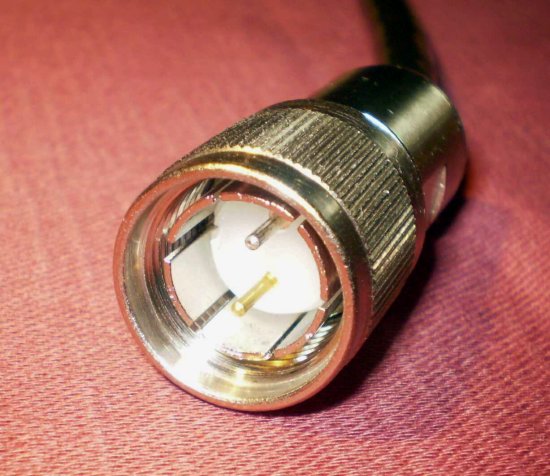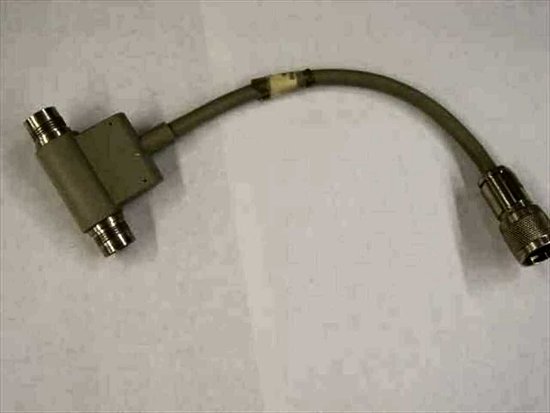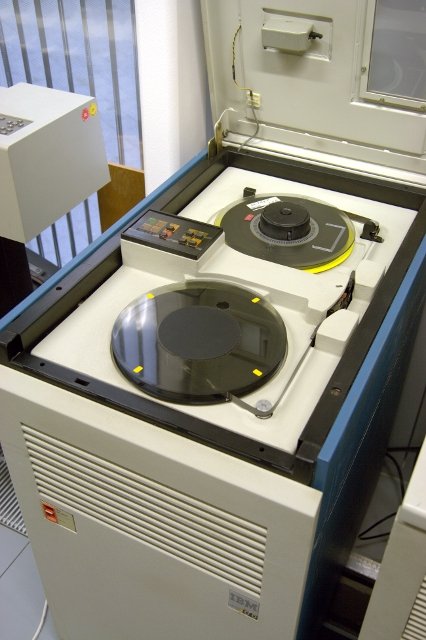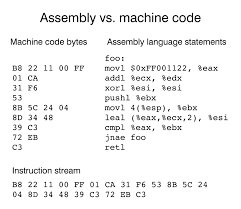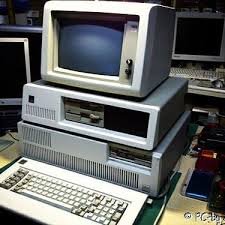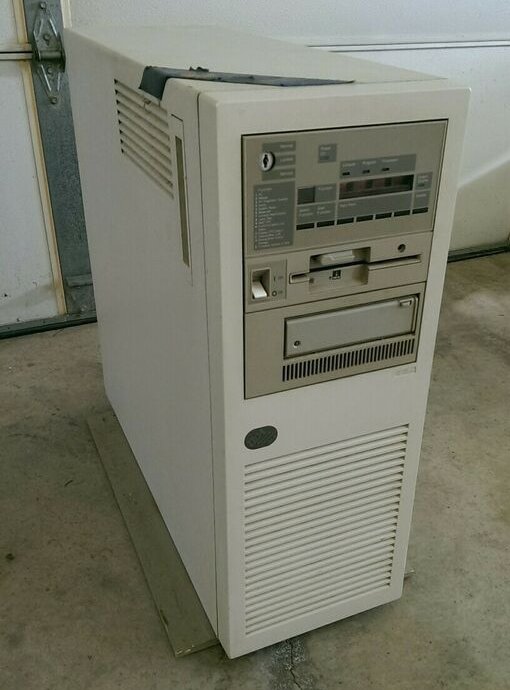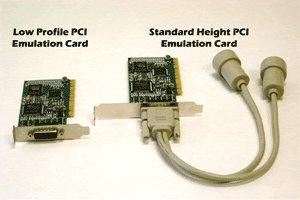The rest of the ad agencies. Continue reading
We installed at least part of the GrandAd system at all of the companies listed below. A few may have actually been Datamaster clients. My recollections of some installations are very dim. In a few I had little or no involvement
Although Keiler Advertising evidently had a famous red door in the twenty-first century, in the eighties the most famous red door in Hartford’s advertising community belonged to O’Neal & Prelle1 (O&P), the agency that was housed across the street from Bushnell Park in Hartford. Our negotiation was with Bill Ervin2, who was, I think, already the president of the agency.
We got this account because of a phone call from Paul Schrenker, the graduate student hired by our marketing company (described here). Paul called dozens of presidents of ad agencies. Bill responded that he was interested in our system. This was probably the only positive outcome from that endeavor.
I seem to remember that O&P bought a model 5364 from TSI. I do not remember doing any custom programming, but we almost always at least customized the invoices that they sent to clients.
I worked mostly with Liz Dickman, who was the bookkeeper. Of all of our agency liaisons, she was among the best to work with. She was able to do the reconciliations by herself more quickly than anyone else. I am not sure who drew the following beautiful schematic of the installation. It certainly is not my handiwork.
Here are my most vivid memories:
- On one visit I had to carry something down to the basement. Halfway down the staircase I felt a stabbing pain in my right knee. It did not last, but it was the first time that I had felt pain there since I recovered from the operation in 1974, as described here.
- If I was at O&P at lunch time, I generally bought a couple of tacos from one of the food trucks. I then sat alone on a bench in Bushnell Park and chowed down. One day while I sat with my legs crossed a starling popped up on my right shoe, which was about six inches off the ground. He perched there for at least a minute or two to see if I would reward him for his clever trick. When I failed to do so, he flew away.
- I recall Liz informing me that she planned to take the CPA exam as a flyer. She said that she did not study for it, or at least not much. She was legitimately shocked when she later learned that she had passed. Perhaps it dawned on her that she was suddenly overqualified for her job. They made her a vice-president.
- The installation really went downhill after Liz departed. The guy who operated the computer called TSI and asked for some training. We scheduled a day for him at our office in East Windsor. He was shocked when we billed O&P for it. Evidently either no one told him that TSI had a contract with O&P that clearly designated how much free training (plenty) they received, or someone gave him some bad advice. O&P didn’t pay the bill, and shortly thereafter the agency announced its liquidation.
I am pretty sure that we sold a model 5364 to Eric Tulin Inc.4 of Hartford, CT. It might have been TSI’s developmental system. I can remember spending a few days at the office on Hamilton St. The primary operator was a guy, but I don’t remember too much about him. I must have met with Eric as well, but I don’t remember the occasion.
The agency was not very large at the time. I don’t think that they had more than five or six employees.
I recall even less about Knorr Marketing5, which was (and still is) located in Traverse City, MI, which is in the northwest part of Michigan’s lower peninsula. The agency, which must have already purchased a S/36, called TSI one day out of the blue.
We sent them some materials, and even though they had never sen a demo, they purchased some portion of the GrandAd system. We sent Kate Behart to do the installation and training. Because we used almost exactly the same system for our record-keeping, Kate knew the accounting and job costing portions of the system. So, I assume that we did not install the media portion.
Kate must have done a good job. We hardly ever heard from them, but Knorr Marketing sent us a Christmas card for many years.
Another mystery GrandAd client for me was Brannigan-DeMarco of New York. They purchased their hardware from IBM. Sue took care of this account. I am not sure how much of the GrandAd system they used.
Sue worked closely with Angela Vaccaro, who was the primary operator of the system. She called for support every few months. Sue always took care of her problems.
Similarly, I know very little about Sullivan & Brownell6 of Randolph,VT. Sue handled everything about this account, too. She visited them occasionally. Sue did not need much of an excuse to schedule a trip to Vermont. She has always loved the whole state.
The only thing that I recall about the account was the fact that the media director was a Black woman. That would not ordinarily be even a little surprising, but this was, after all Vermont. In 1990 there were a grand total of 1,951 Black people in the state, including exactly zero lawyers and judges. In fact, only eleven Black people in total lived in Randolph.
Sue told me that the media director and her husband had a farm in the vicinity. Sue told me that she might have stayed overnight there once or twice.
Using a chain saw the husband carved a fox out of a tree trunk and gave it to Sue. It sat placidly on guard out in the grass just beyond the parking spaces of our office in Enfield for many years. In 2021 it wards off coyotes in our back yard. I took a photo of it. It has seen better days.
I handled most of TSI’s interactions with Knudsen-Moore (K-M), an advertising agency located in Stamford, CT. I thought of this as an important account because it finally gave us a toehold in the southeastern (wealthy) part of the state. I also thought that it was cool that one of our clients did business with both King Oscar and the WWE (then known as the WWF).
The audience for my demo was the seventy-two year-old7 bookkeeper whose name was Irene. I must have brought a PC, our 5364, and a terminal that we were evaluating for another client. Its screen was very large for the time. This became important because the bookkeeper had very bad vision. In fact, she later confided to me that the reason that she insisted that they choose TSI’s system was because of that terminal. Ordinarily my strikingly good looks are the deciding factor, but as I mentioned, her vision was poor.
It took us several months, for reasons that will soon be apparent, to get them up and running. During this period the agency changed hands not once, but twice. Its final name, which persists to May of 2021 was CDHM8.
The holdups for going live with the system were the balances in accounts payable and accounts receivable. The values in these accounts are generally positive for A/R and negative for A/P. If a vendor bills you $100, and you immediately bill the client with a 10 percent markup, A/P will have a transaction with a value of -100, and the entry in A/R will be +110. There will also be offsetting entries, of course. The point is that every company should be able to justify its A/P with a stack of unpaid bills from vendors and its A/R with a stack of open invoices sent to clients.
I entered in all of the open A/P and A/R into GrandAd. I printed a list of each with totals. The system’s totals did not agree with what Irene’s hand-written worksheets said were the current balances. Not only that; her balances, which were reflected in the company’s official general ledger, had the wrong sign! The A/P showed a positive balance, and the A/R showed a negative balance. According to these figures the agency’s vendors owed them money, and they were in debt to their clients!
Irene still insisted that her figures were right. I asked for a meeting with the president, Bill Hoag. The bookkeeper attended, as did a couple of other people. Their accountant was not present. I explained the situation with words similar to those of the previous paragraph. She insisted that her numbers were correct because she had checked every entry. She knew this because there was a little dot next to each figure. Much screaming ensued.
The lady had been using the “balance forward” method. After each transaction a new balance is calculated. This is OK, but at least monthly this balance must be checked against the list of invoices. She had NEVER done this. I later looked over her sheets. They were replete with errors. She simply could not read her own handwriting.
The irony of the situation did not strike me until much later. If someone had caught this egregious error earlier, we would not have won the contract. She recommended us solely because of the big screen on the terminal, remember?
How in the world could an agency with books in this deplorable condition be sold twice? I don’t know.
They asked the bookkeeper to retire. The guy that replaced her was, in some ways, worse.
I am pretty sure that his first name was George. I don’t remember his last name, but I do remember that he insisted that any communication to him include the title “Esq.” Now, I don’t pretend to know who gets to use that title, but I would be willing to bet that not many of them lived at the YMCA, which is where this character lived. George got into arguments with us all the time, and he was abusive to TSI’s employees.
For the first and only time, I finally called the agency’s president about George’s behavior. He said that he would look into it. He called me back less than hour later. He said that the guy had not been in all week, and he was now officially terminated.
The next week the president told me that they had hired a new person. I think that his name was Roger. He was very easy to work with, and he had the record-keeping straightened out in short order.
I drove to CHM an least half a dozen times. I never saw Vince or any other McMahon. It was a big disappointment.
Sue handled the account of Charmer Industries of the Astoria section of Queens. The company distributed wine and liquor products. This was probably a referral from Quique Rodriguez, an IBM rep with whom we had a good relationship.
Sue and I drove there on, as I remember it, a Sunday, carried their computer and printer into the building, and made sure that they were working. Then we drove back to Rockville. I found the whole drive within the city terrifying. I wanted to stop, get out of the car, and kiss the earth when we were back in Connecticut. I have been to NYC many times, but I have never driven inside the city limits.
Charmer had a lot of companies. One specialized in the design of point-of-sale products in bars and liquor stores. Over the years it went by a number of names, including ACC Marketing and the Sukon Group. These were the people who used our system.
Our final liaison in the nineties was Ed Wolfe. As I recall, the company later decided to purchase a small AS/400, the system that replaced the S/36. The AS/400 is described in some detail here. I took the train to New York a couple of times to help with the setup of the new system. Ed was a nice guy and a good client.
I have always thought of Doherty-Tzoumas of Springfield, MA, as a bizarre advertising agency. Dianne Doherty9 was the president. She was totally unsuited to running this agency or any other business. Her husband was a very prominent lawyer. I think that he must have set her up in this business, perhaps for tax reasons. I can only speculate.
Her partner, Marsha Tzoumas10, knew her way around advertising and the business world at least a little, and she was very nice. I felt a little sorry for her.
The agency certainly tried hard to succeed. It always seemed to be a beehive of activity. Quite a few employees had been hired. They liked to hold “focus groups”11 for their clients’ products or services, an idea that I had never previously encountered.
I worked with Marsha and the agency’s bookkeeper to set up the system, and for the most part it seemed to go rather smoothly. However, when we showed the reports for the first monthly closing to Dianne she was overwhelmed.
Dianne hired a financial consultant to help her run the business. He might have been the company’s accountant, but that is not my recollection. I was in a few meetings with him. Most of them were fine, but in one meeting we were discussing the general ledger. Dianne made a very peculiar request. She asked if there were just two or three accounts that she should concentrate on. The request was, in my opinion, absurd. There might be a few that she could pretty much ignore, but to try to focus on any small subset of a company’s books was unthinkable. Most small businesses fail, and there are many paths to failure.
Nevertheless, the consultant took the bait and named a few accounts. I can’t even remember which ones he chose. I assume that cash was one. It is generally a good idea to know how much cash you have. He probably also picked A/P and A/R.
At any rate I knew in that instant that this business was doomed. I was right. In 1991 we received a letter from Dianne’s husband Paul proclaiming that the business was being liquidated. It was the only such letter that we ever received from an ad agency. They owed us less than $100, and so we did not consider suing for it.
I remember that on one occasion Marsha mentioned that she was looking for a good book to read. I recommended Larry McMurtry’s Lonesome Dove. I wonder if she took my advice.
In 1987 Rossin Greenberg Seronick and Hill (RGS&H)12 was the hottest agency in Boston, MA. The president, Neal Hill13, was not an advertising guy. Although I never met any of the other three partners, I am sure that they all had a good deal of advertising experience.
The agency had enjoyed two years of explosive growth. It wanted a computerized system for word and data processing. Neal and Ernie Capobianco14, the director of finance, interviewed us and all of our principal competitors. Their choice of the GrandAd system was a real feather in our cap. We were confident that we could do a great job for them, and we hoped that it would open the Boston market, which we had previously never been able to crack, for us.
The holdup was the word processing element. Neal loved Wang’s approach to word processing, and he thought that DisplayWrite/36 (DW/36) was inferior. However, no ad agency software had ever been written for Wang’s operating system. In fact, I had never encountered anyone who used it for anything other WP.
When Neal told us that they had decided to use our system, he asked what we would recommend for word processing. I said that I was not an expert, but the future was in PC’s. Furthermore, if they planned to use the S/36 only for GrandAd, a 5362, which could support up to twenty-eight locally attached devices, would be more than sufficient.
My assessment turned out to be correct, but in 1987 buying PC’s with good word processing software (the most popular at the time was WordPerfect) and connecting them would have been a formidable task. Personal computers in those days were still really personal.
Neal insisted that one system should address all the needs. IBM persuaded Neal that a model 5360 with DW/36 would serve their needs.
In the meantime I received a phone call from a salesman at Wang. He wanted us to convert our software to run on Wang’s equipment. I informed him that this would be a monumental task, and, although we had dozens of successful installations on IBM hardware, we had absolutely no experience with Wang’s approach. He told me that if we agreed to convert, he had an agency lined up that would use our system. I asked him if he was referring to RGS&H. When he confirmed it, I told him that they had already signed a contract with us. This was news to him.
The system that IBM proposed included terminals for almost all of the employees. The ones with PC’s got 5250 emulation adapters. Our end of the installation went fine. We did a great deal of custom coding for them. They had spent a lot of money on the system, and they reasonably insisted that it do exactly what they wanted.
Then the bombshell exploded. Microsoft let the world know that Neal Hill had written a letter to them. In it he bragged that RGS&H had poached the copywriter and artist from the agency that had handled advertising for Lotus Development, which at that time was considered Microsoft’s biggest competitor. Microsoft had not yet assembled its Office package, and Lotus 123 and Approach were very popular applications. Neal said that RGS&H knew what Lotus was up to, or words to that effect. He also sent them two plane tickets from Seattle to Boston.
I could sympathize. Evidently no one checked Neal Hill’s work either.
This episode caused a major scandal that has been widely written about in legal, advertising, and business circles as well as in the local press. In fact, if you google the agency’s name you will get several pages of articles about it. There are so many that is very difficult to find any other information about the agency.
Neal resigned in December of 1987. Ernie was named as the interim president. Our system was fully functional by this time. Ivan Dunmire served as our liaison. He did an excellent job.
TSI indirectly got swept up in this brouhaha. The articles in the local press mentioned that RGS&H had recently purchased a computer system that was characterized either as a mainframe or as a system that was much too large for the company. So, despite the fact that the people who actually used our software appreciated greatly what we had done, we never had the good reference account in Boston that we had hoped for.
Here are some of my recollections of my experiences with RGS&H:
- When I was driving Ernie to lunch one day he complained that my car smelled like tobacco smoke. It must have been Sue’s. Nobody previously had mentioned it. Evidently I was “nose blind” to it.
- One of the two contenders for the most harrowing experience of my life (the other, getting caught in the Blizzard of ’77, is described here) occurred when driving back to Rockville. It was snowing lightly, and the traffic was moving at a fairly steady pace on the Mass Pike when I reached Exit #9 for I-84 near Sturbridge. To my surprise I-84 was nearly empty. There were no tracks in the road at all. I could clearly see the reflective markers on both sides of the road, and I used them for navigation. There really was no place to stop between Sturbridge and Rockville. The Celica and I passed no one, and we were only passed by one car traveling at perhaps 30 mph. A mile or so later I saw a car that had slid into the median; I assume that it was the one that had passed me. I did not consider stopping. When I finally reached the exit for Rockville, I had to guess where it was; the asphalt was covered with several inches of snow and there were no tire tracks. I did not think that my car would make it up the steep hills in Rockville, but it did. Sue was very worried; there were no cellphones in those days.
- After we moved the office to Enfield in 1988, I usually drove to Springfield, took a Peter Pan bus to Boston, and walked a few blocks to the RGS’s offices. By that time “&H” had been dropped from the agency’s name.
- I loved working with Ernie, Ivan, and the other people at the agency. There were no quarrels or misunderstandings.
- I remember that I usually walked to McDonald’s for lunch and ate a Quarter-Pounder with Cheese and a Big Mac.
- In the nineties Ivan called us a few times for support. By that time PC networks were becoming widespread, and people were touting the idea of “client-server” systems, a term that simply meant that the data was on one system used by everyone, but each person’s computer had its own set of programs. However, Ivan said that many of the people at the agency did not understand this. They thought that the term designated a system constructed to provide better service to the agency’s clients, and they wanted to know why RGS did not have one.
I tried to recruit Ivan to work for TSI, but he turned us down. I am not exactly sure what role he would have played at TSI, but I am pretty sure that he would have done a good job.
Our other installation in Boston, Rizzo Simons Cohn (RSC), was an even bigger fiasco. I was surprised to discover that Sue has almost completely repressed the memory of The Sign of the Three.
We had been contacted by a firm called Computer Detectives (CD). The guy on the phone told us that his company had been hired by the agency to find a computer system for them. It turned out that CD was a two-person company, the guy with whom we talked and his wife. His name was Larry Ponemon16. I don’t recall hers. We dealt almost exclusively with Larry.
Sue and I went to supper at a Chinese restaurant with them. The both ordered moo shu pork; this is the only thing that Sue remembered about them. They were very surprised when we told them that we had never really had a vacation.
We showed them the system, and they liked what they saw. We gave them a proposal for the GrandAd system running on a S/36 model 5363.
Larry called us to tell us that they had recommended our system to RSC, but the agency preferred to run its system on 3B2, a UNIX computer manufactured by AT&T. They asked us if we could convert our system to run on it.
We researched whether the S/36 version of Workstation Basic17 would work on a 3B2, and we were assured by the company that wrote and marketed it that it would. We told CD that we were pretty sure that it would, but we would need to adjust our quote to cover the conversion costs. We did so.
We then got to meet another consultant, who, among other things, sold and marketed AT&T computers. We told him that we were accustomed to working with IBM, and we trusted its commitment to support. If he sold the system to RSC, we wanted to know whom we would contact when we had problems or questions. He said that he was our contact. Remember that there were no cellphones, and this guy practically lived in his car. We would need to leave messages. The best that we could hope for was a beeper. Then we would need to depend on him to find someone who was willing and able help us. We were used to dialing 1-800-IBMSERV from anywhere. Someone ALWAYS answered.
The CD people were there at the meeting. They and the AT&T guy assured us that we and the agency’s users would get all the support that we needed.
We converted the software to work on Unix without an inordinate amount of difficulty. That, however, did not mean that it would efficiently do everything that RSC wanted in their environment. We knew nothing about how the operating system would perform when numerous users were working on the same files at the same time. Sue spent several days at RSC trying to get the system to work, but she ran into one roadblock after another, and no one was available to help her.
After a few weeks of this foolishness, the agency got fed up. CD had not disclosed to RSC, who had paid them handsomely to conduct the search, that they were being paid a “finder’s fee” both by us and by the AT&T guy. RSC had never voiced any preference for hardware; that was just a lie. Evidently they had told RSC quite a few whoppers, too. RSC sued CD, and Sue testified for the agency. AT&T took the hardware back and refunded at least part of the cost.
RSC reopened the software search. We submitted the same proposal that we had previously given to CD. Since we had already been paid for the UNIX version, we charged nothing for the GrandAd software or for the customizations. The other contender was a New York company (I can’t remember the name) against whom we often competed. Its software ran on UNIX.
I called the finance guy at RSC, Jonathan Ezrin18, and asked about their decision. He informed me that they had chosen the other vendor. I asked him what the basis for the decision was. He responded that mostly it was the cost. The answer astounded me. I asked him what the other software company had bid. It was about $10,000 higher than ours. I asked him how they could have considered this less than our bid. He said that to be fair they had included the cost of the software in our original proposal when making the comparison.
I assured him that we were not going to give that money back. I then told him frankly that theirs was the stupidest line of reasoning that I had ever heard, and I slammed down the phone.
RSC dissolved in 1990, less than a year after that phone call. I don’t know what happened to CD. I found no trace of them on the Internet, although Lavinia Harris has published a series of novels about a young couple who call themselves “computer detectives”.
I remember visiting Fern/Hanaway19 of Providence, RI, a few times. The agency had a System/36 that they had bought from IBM. I think that we installed one or two modules there, but I don’t remember which ones.
IBM must have told Arian & Lowe (A&L)20, an advertising agency of sorts in Chicago, IL, about TSI. Sue said that she went there once. She remembers that the floor of their office would have been good for dancing, but the only thing that she remembered about the company was that their main client was the Beef Board. They mostly produced point-of-sale posters and signage.
I installed some modules of the GrandAd system there and flew out for a couple of month ends. I remember several very strange occurrences.
- The Director of Financial Operations for the agency was Neta Magnusson21. We generally had lunch together. She always had more than one martini. I could never have concentrated in the afternoon if I had imbibed a small fraction of what she downed. I stuck with Diet Coke or iced tea.
- A&L used its S/36 model 5360 for word processing. One time when I was there working on the GrandAd system, they somehow lost some WP documents. A few people blamed me for this. I protested that I had not done anything to any documents. Fortunately I knew enough about how DW/36 worked that I could also demonstrate that I could not possibly have done anything.
- I ordinarily stayed at a Holiday Inn that was a short distance from A&L. On one trip I had to stay an extra day. The Holiday Inn had no availability for that extra night, but they found me a place to stay and called a cab to take me there. The cab driver said that I definitely would not want to stay there. Instead, he took me to another place that was in a rather rough part of town. However, the room was OK, and it was only one night. I was, however, happy to be out of there the next morning.
- The agency’s was in downtown Chicago. I had to take cabs back and forth to O’Hare. One time I somehow left my glasses in the cab. Believe it or not, the next time that I went to A&L I stopped at the taxi dispatcher. My glasses were in the Lost and Found box safe and sound.
- One of the cab drivers spoke no English at all. His girlfriend sat in the front seat and translated for him.
- Another cab driver picked me up at A&L. I wanted to go to O’Hare. He asked me for directions. I actually rode with a cab driver in Chicago who did not know how to get to the airport! Fortunately, this was one of my last trips to A&L; I could have given him instructions blindfolded.
- The favorite expression of the system operator at A&L was “Have a good one!” I realized that this was cheerful and completely innocuous, but for some reason it really irritated me.
- My favorite part of the trips to Chicago was the prospect of having an Italian beef sandwich, either at the airport or bought from a street vendor.
It seems appropriate to end with the bittersweet tale of Charnas Associates of Manchester, CT. TSI and IBM scheduled a presentation to the agency at the IBM office in Hartford. The presentation was scheduled to take two hours. I went to the office early and loaded our GrandAd demo system onto the 5360 at IBM. I also went over my notes for the presentation.
The turnout was unbelievable. Around twenty people showed up from the agency. I was always happy if we got one; I had done worse than that.
I had a lot of experience at this. The format varied by only a little. Someone from IBM acted as the host. He or she was always dressed impeccably and spoke glowingly about how wonderful IBM’s systems and support were and what a close working relationship IBM had with independent software developers like TSI. Then they turned it over to me.
Not this time. The IBMer went around to each and every person in the room and asked them what they would like the computer to do to help with their jobs. After each answer he would rush back to a whiteboard and add it to the list of items that were already on the board. The he would ask them to evaluate how important this was to them. He was hoping that they would attach a monetary value to it, but he was willing to settle for peace of mind or saving time. He dutifully recorded the values as well.
This went on for at least an hour and forty-five minutes. Then he spent a few minutes praising the System/36 before he let me talk for a couple of minutes. I could not possibly do my presentation in less than a half hour. So, I had to forget about my slides and my demo and try to talk about the big picture. The worst part was that damnable list on the whiteboard behind me. Needless to say, our software addressed less than half of the wish list. Of course no one suggested “Help us find which clients are unprofitable and why” or “Help us improve cash flow”.
I was so angry at the IBMer that I could have punched him. If I had not sworn after that fight in the fifth grade with Tom Guilfoyle that I would not engage in fisticuffs, I might have.
We followed up on this, but we never heard from Charnas.
A few years later in 1989 I was scheduled to give my first AS/400 demonstration of the AdDept system that I was still in the process of installing at Macy’s in New York. TSI did not own an AS/400 yet, and so I had made a backup tape at Macy’s. I planned to install Macy’s programs and data, dummy up the data so it was not recognizable, give the demo, and then erase the programs from the disk.
I never finished the first step. Something about the tape made the AS/400 system at IBM hang up. Commands could not even be entered at the system console. I worked with these incredibly reliable machines for twenty-six years. This was the only time that I saw something like this happen.
The IBM people were furious at me. They were certain that the problem occurred because our programs were written in BASIC. I calmly explained that the programs never got restored. Something happened during the restoring process.
Nobody from IBM attended my demo. I went to the demo room to do a song and dance with no accompaniment. Only one person was there, and she was not even one of our invitees. She identified herself as a media buyer at Charnas who had heard about the event from one of her clients. I explained how the GrandAd system worked and which agencies were using it.
She told me that Charnas had a S/36. She did not know the model. I asked her how big it was. “Oh, it’s big!”
She said that they used it only for word processing, and everyone hated it. That guy from the first demo had sold them a 5360 with no software except DisplayWrite36!
I don’t remember what happened after that too clearly. I am sure that I went to Charnas’s office in Manchester at least a few times in the early nineties. I think that I installed an abbreviated media system for them. Then I got heavily involved in the AdDept system.
Charnas apparently went out of business in July of 1992.
While I was looking for information about the agency I came across the book shown at the right. It was commissioned by Robert Bletchman, an attorney from Avon who died in 2008. His obituary is here.
There is only one copy of the book on this website. The title is How to Achieve the Release of Unidentified Flying Object Information from the United States Government.The first reader with $50 can claim it. Shipping is free!
The publication date for this book is in 1985. I am pretty sure that this effort antedated Art Bell’s Coast to Coast AM show on WTIC radio by approximately ten years.
1. O’Neal & Prelle went out of business in 2000.
2. Bill Ervin died suddenly in 2003. His obituary is here.
3. Liz Dickman is now the CEO of Integrated Physicians Management Services in East Hartford. Her LinkedIn page is here.
4. Eric Tulin Inc. changed names and ownership a few times before giving up the ghost in 1991.
5. Knorr Marketing’s website is here.
6. In 2007, as reported here, Tom Brownell apparently transferred his client list to a group of his employees. They changed the name of the agency to 802 Creative Partners and moved the headquarters to Bethel, VT.
7. By coincidence 72 is my own age as I write this in May 2021. To be honest, if I tried to keep a manual ledger, I probably would not be able to read my handwriting either.
8, The agency’s website is cdhm.com.
9. Dianne Doherty now goes by Dianne Fuller Doherty. She resides in Longmeadow, MA, in 2021. After the agency’s failure she devoted her life to helping other small businesses, especially those run by women, get started. Her story is described here.
10. Marsha Tzoumas is now known as Marsha Montori. In 2021 she is the Chief Marketing Officer at Six-Point Creative Works, an ad agency in Springfield. Her LinkedIn page is here.
11. I used focus groups in my short story (described here).
12. RGS&H went through five name change. Its final incarnation, GSOD, Inc. dissolved in 2007.
13. Neal Hill landed in Canada. His LinkedIn page is here.
14. Ernie Capobianco telephoned me in the early 1990’s. At the time he had just started working at Valentine-Radford, a big ad agency in Kansas City. He arranged for me to meet with some principals and the IT guy. I also visited Ernie’s apartment in Johnson County. I think that I caught him at a bad time. His LinkedIn page, which skips over his time at RGS&H, is here.
15. Ivan Dunmire lives in New York City. His LinkedIn page is here.
16. I think that Larry Ponemon now runs the Ponemon Institute, which has something to do with privacy, security, and computers. His page on the organization’s website is here.
17. Workstation Basic was designed to emulate the Datamaster version of BASIC running under DOS and later UNIX. More information is here.
18. Jonathan Ezrin apparently now lives in Plymouth, MA. He does not have a LinkedIn page.
19. Fern/Hanaway was dissolved in 1998.
20. It appears that in 1991 A&L was taken over by Daryl Travis. Various versions of Arian, Lowe and Travis (no Oxford comma) existed after that, but I think that the operation in Chicago did not survive for long. The Beef Board account represented a high percentage of its billings.
21. I think that in 2021 Neta Magnusson lives in Geneva, IL, a suburb on the west side of Chicago.



